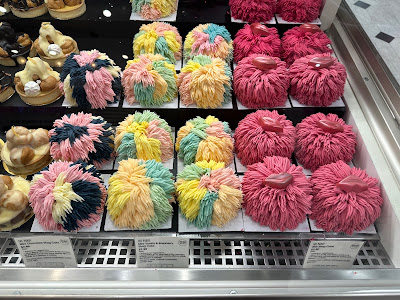Headed off to Kew Gardens on a route not along the Thames, otherwise it would have been a walk of way way way over nine miles. I am getting to see a number of neighborhoods in this big city.
The first part of the walk went through St James Park and Hyde Park. And it was not so early that, ahem, one should still be sleeping:
Most of the walk was through busy commercial streets. Whatever they are building here, they are employing more cranes than the four or five—considered a lot at one site— used in the building of the two new colleges at Yale:
When you get right down to it, Botanical Gardens are different from gardens like Hidcote. The latter are beautiful, decorative places, whereas botanical gardens' primary purpose is to collect species, study plants, and do research, therefore most of the flowers are grouped taxonomically. My self-appointed editor—you know who you are—correct me if I am wrong!
There were some pretty beds, but I don't have any good photos to support that claim. The greenhouses were fabulous!
Note the appendage with the red pod-like thing emerging from the clump of bananas:
This is a palm that flowers and fruits underground (or maybe this is not that exact palm, but there is a palm that does that). Most palms are pollinated by insects, but regarding this one, researchers have observed seeds being dispersed by foraging pigs.
A flower:
Water lilies:
So spectacular they merit two pictures:
Those saucer-like plants remind me of the poem about Wynkin, Blynkin and Nod who sailed off in a wooden shoe. They could have used these and had a more comfortable journey!
Now here is a factoid:
These are the fruit of the sago palm:
Very appealing looking, but ¡ojo!, beware!
A dangerous delicacy
The common name sago palm refers to the edible starch derived from the spongy centre of this species stems, roots and seeds. Cycads contain a toxic compound called beta- methylamino-L-alanine (BMAA), so it must be processed before being eaten.
BMAA is linked to a neurological disease known almost exclusively from the tiny island of Guam where sago is a staple food. One theory points to fruit bats as the trigger for this disease. The bats eat large quantities of cycad seeds and so accumulate the toxin; humans then eat the bats and accidently consume the poison. A decline in bat population has been found to correlate with fewer cases of the disease. Less bats - less humans with BMAA.
Killer bread?
People make the stems, roots, and seeds of sago palm into a spongy type of bread. It is a long process that removes poisonous chemicals found in the plant. If you don't do it right, these chemicals can cause a deadly disease that affects the nervous system.
There is so much to learn about in the world of growing things!
After the Gardens, I walked two miles to a bus stop, where I took a bus, yes, to the neighborhood, more or less, where Selfridges is, OK so a mile plus change distant. I just had to see their food halls so that I could compare them to those of Harrods. Harrods wins thumbs down, but I did buy a good lamb kebab that came with a container of tomato and feta salad and some delicious hummus. I also bought some weird candied popcorn destined to end its life in the trash, and two bottles of a carbonated lemon drink.
I wonder, should I have purchased one of these?
Whether or not that is a rhetorical question, I am not sure!










No comments:
Post a Comment